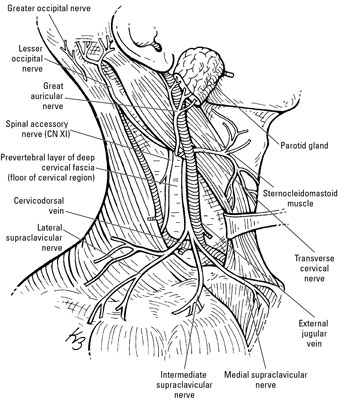It s about the posterior triangle of the neck today.
Floor of posterior triangle of neck is formed by.
A map is a scale a anterior scalene m middle scalene p posterior scalene sc splenius capitis le levator scapulae.
It is subdivided by the diagonally placed inferior belly of the omohyoid.
Pus in the posterior triangle arising from tubercular cervical vertebra may track downwards in the axilla.
Ventral rami of c5 t1.
The muscular floor of posterior triangle is covered by prevertebral fascia which extends around the brachial plexus and axillary artery continuation of subclavian artery as axillary sheath.
The posterior triangle is bounded by the scm trapezius and middle third of the clavicle with a muscular floor formed by the lateral deep cervical muscles.
The following structures are superficial to the prevertebral tascia.
The posterior middle and anterior scalene muscles.
The occipital triangle and the subclavian or supraclavicular triangle.
The omohyoid muscle divides the space into two triangles.
Splenius capitis levator scapulae.
The borders of the posterior triangle of the neck are formed by the trapezius muscle posteriorly the sternocleidomastoid muscle anteriorly and the omohyoid muscle inferiorly.
It is bounded in front by the posterior border of sternocleidomastoid behind by the anterior border of trapezius and below by the inferior belly of omohyoid.
The floor of occipital triangle is formed from above downward by a a part of semispinalis capitis occasional.
Floor of the posterior triangle includes the.
By teachmeseries ltd 2020 fig 1 the borders and floor of the posterior triangle of the neck.
The posterior triangle of the neck is covered by the investing layer of fascia and the floor is formed by the prevertebral fascia see fascial layers of the neck.
The floor of the triangle is formed by the splenius levator scapula scalenus medius and the anterior scalene muscles.
The roof is formed by fascia and the floor is formed by the splenius capitus levator scapulae and scalene muscles.
Posterior triangle of neck ppt 3 study guide by uab21 includes 92 questions covering vocabulary terms and more.
Courses from the hyoid bone en route to the scapula within the pretracheal fascia.
The inferior belly of the omohyoid muscle crosses the triangle about 2 5 cm above the clavicle.
Most apparent within the superior occipital triangle is the lower half of the external jugular vein.
The floor of the posterior triangle of the neck is formed by the prevertebral layer of deep cervical fascia covering the following muscles.
The prevertebral fascia forms the floor of the posterior triangle of the neck figure 26 1c and d.
How to remember the borders of the posterior triangle ctscan c clavicle t trapezius s sternocleidomastoid how to remember what muscles form the floor of the posterior triangle.

